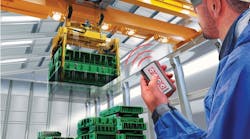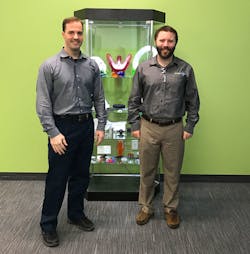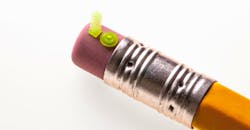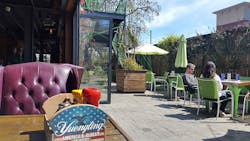As 3D printing matures, engineers are seeing more benefits from using this process. Wanting to know more about who is using 3D printing and why, I ran down to Raleigh, N.C. to visit Proto Labs’ 3D printing facility to get a first-hand look…and some answers.
My tour guide was Eric Utley, an applications engineer with more than seven years of experience in rapid prototyping and additive manufacturing. His focus is on stereolithography, selective-laser-sintering and direct-metal laser-sintering technologies, and provides guidance to engineers on designing for manufacturability. During our tour, I was able to ask him some questions.
Jeff Kerns (l.) ready to go on tour with Eric Utley (r.), Applications Engineer at Proto Labs.
Where does 3D printing fit, or what are the features that cause a part to land in a 3D-printing process instead of a traditional one?
Like most engineering questions, it depends. Generally, the lower the quantity and the more complex the geometry, the more likely 3D printing is the ideal manufacturing process. If the part has features that are unmanufacturable with traditional processes, then 3D printing can be the only way to make something. Usually, geometries with complex internal features are only possible with 3D printing.
3D printing allows you to economically test multiple prototype iterations before investing in an injection mold. 3D-printed parts are perfect for fit and form checks before moving on to the next steps in the design process.
Does having the opportunity to print iterations lead to a mentality of “shooting from the hip,” rather than using proper design work?
That could be a possibility. However, I think designers are using 3D printing to see how a product performs. We get a lot of prototypes of acoustic parts and spray nozzles, for example. Often, the only way to accurately determine if it works the way you want is to have a physical model. Computer modeling is great, but it’s still just a digital representation. I wouldn’t call using 3D printing for this type of testing “shooting from the hip.”
Needing a steady hand to finish detailed small parts, I didn’t notice any coffee in the finishing room. Making sure a tiny hole or feature isn’t missed in the finishing process is important. This makes the checklists with key features on them imperative to achieve a good finished product.
You have a lot of stereolithography (SLA), selective-laser-sintering (SLS), and direct-metal laser-sintering (DMLS) machines. Do you offer plastic extrusion, or fused filament fabrication (FFF)/fused deposition modeling (FDM)?
Not currently. It was 2001 when we entered 3D printing, and our focus was always on crisp resolution and tight tolerances. Then and now, SLA provides the highest resolution in the industry. FDM quality was quite poor in the past, but admittedly has improved in the last few years. FDM also allows for some specific materials not currently possible in any other 3D-printing tech. We do not offer it now, but I cannot rule out us possibly adopting it in the future. For now, SLA and SLS has been able to handle it.
What are the differences between the processes you do offer?
For SLA, we have a host of materials. We even have our own proprietary resin. However, most of our SLS parts are done in nylon 11 or 12. Then moving into DMLS, it’s metal. So right off the bat, there are the material differences. We have other processes, like injection molding and machining, just not at this facility. Most of our 3D-printing work is for runs anywhere from one to a couple hundred. After that, unless you need 3D printing because of complexity, we normally will find something like injection molding will actually be a better fit.
Eric mentioned the SLS can feel like an archeological dig—like sifting through the sand to find all of the parts.
I would say over 50% of our business is doing between one to 25 parts. That is enough to test, or figure out, what the design needs to move to the next iteration. Once you get beyond 25 parts, you can find some better properties in molding. In addition, if you do use injection molding to make larger volumes, you already have a mold. If the part is 3D-printed for final production, it’s normally due to complex geometries or internal features.
What are the benefits offered by these processes?
SLA has high resolution, and can offer extremely small details or complex geometries. This works well in the medical industry, which needs tight tolerances and custom-fit parts. This is good for small parts and printing multiple parts in one. SLA also offers low surface roughness. If you are using a material that is see-through, you can see through the layers without finishing it. After finishing, you can barely see the layers.
Preparing a part is important for SLA. Our staff minimizes support material. Support material can increase the finishing time on a part, and must be done by hand. Sometimes more material will go into the supports than the part.
For Polyjet, there is a wax-like support material that can dissolve away, but this can be difficult for complex tubes [he holds up a tube with a complex and multiple pathways; the entire tube is filled with the waxy material]. Polyjet is great for anything elastomeric, or squishy. Anything solid or static might lean toward SLA. It is also interesting to see how industries are using 3D printing processes. There is obviously crossover, but we get a lot of medical for SLA and agriculture for SLS.
SLS is often cheaper, and stronger. You sacrifice surface roughness, but you only need to bead-blast the parts of excess powder, which is much easier than the support removal process of SLA. The powder bed lets the powder support the part. This means you can stack multiple parts vertically in a single print.
Notice the vacuum in the technician’s hands. Dust control is important in processes with fine particulate that could be inhaled.
Then we move to a more powerful laser for our DMLS process. The SLS uses a CO2 laser, while the DMLS uses a ytterbium fiber laser. This allows us to build with many types of metal. Most of our jobs are done in 316L steel. We also build in titanium because it’s not the easiest to machine, so even some simple parts might be 3D-printed. It’s interesting, aluminum actually takes more energy to sinter. Its reflectivity and heat dissipation mean we have to increase the power of the laser when building an aluminum part.
What do you personally see for the future of 3D printing?
You need the right process for the right job. 3D printing will continue to grow, but it’s not replacing any of our traditional tools; it’s just adding to it. We launched our Polyjet printing service on March 29, 2017, and we already have jobs lining up. Polyjet printing offers a dynamic print so that you can change the materials and material properties as you print. This works great to print durometer tests to find out the feel a customer wants before going to our overmolding process.
As time goes on, engineers will start to use features like the ones offer by HP to be more creative. I saw a gear printed with an HP printer using different colored layers. When the color changed, it indicated wear so that a technician knows when it needs to be replaced. Better yet, they printed the barcode right on the part. When the wear color shows, they simply scan the barcode to order another one.
I think some of the hype has calmed and 3D printing has really found a home. However, I also think we aren’t done seeing all of the awesome things we can do by advancing the process and materials. Furthermore, as designers start realizing what is possible with 3D printing, innovative and creative solutions alone will accelerate this industry.
You said, over 50% of your work is 1 to 25 parts. How do you keep track of everything?
We have monitors in some of the rooms that track the orders. The software is ours, and it is networked throughout the building to show what orders are where. Once you are in a room with a monitor, though, there are multiple processes that happen before the order is updated. For these steps, we have good old-fashioned checklists. The interconnected network keeps everyone up-to-date throughout the company, while the checklists keep track of every step taken in a department.
Where would you suggest getting lunch?
There is a beer garden about 20 minutes down the road. It has the largest selection of beers in the world.
The lunch destination. Enough said.






